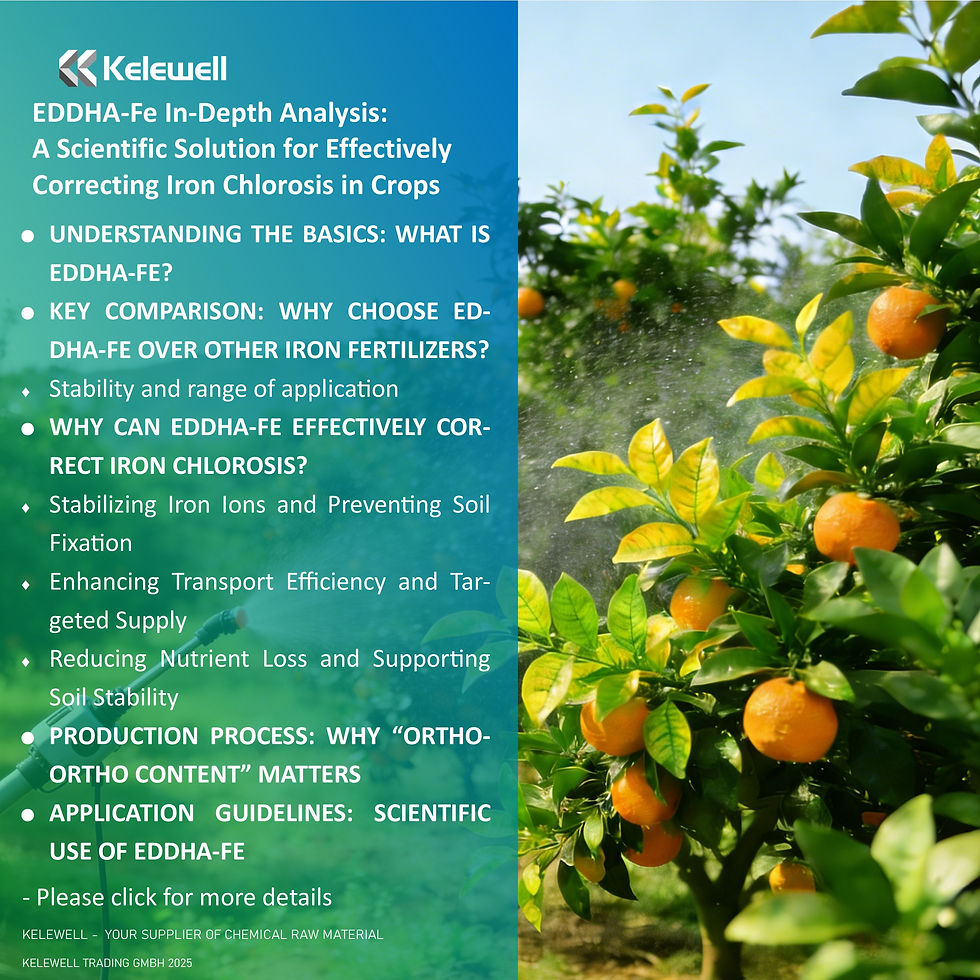Chelated Fertilizers: A Smarter, Safer and More Efficient Nutrition for Modern Agriculture
- Camille W.

- May 7
- 4 min read
What Are Chelated Fertilizers?
Chelated fertilizers are a class of fertilizers produced through chelation technology. The word "chelate" is derived from a Latin root meaning "claw," vividly describing the chemical behavior of these fertilizers. From a chemical perspective, chelated fertilizers contain elements that have undergone chelation to form chelates—complex compounds where a large molecule ligand binds to a central metal ion in a ring structure. Organic molecules capable of chelating metal ions are known as chelating agents or ligands.
In plant cells, chelating agents function like intelligent transport vehicles. They selectively capture specific metal ions and release them in appropriate amounts when the plant needs them. This "capture and release" mechanism enables crops to absorb nutrients more efficiently and rationally, ensuring a balanced nutrient supply across roots, stems, leaves, flowers, and fruits. Chelating agents play a crucial role in plant nutrient transportation and regulation, making their application in fertilizer production a significant advancement in agricultural technology.
Types of Chelated Fertilizers
Not all chemical elements can form chelated compounds. Currently, the most commonly chelated micronutrients include zinc (Zn), iron (Fe), manganese (Mn), copper (Cu), calcium (Ca), magnesium (Mg), and boron (B). The market offers a wide variety of chelated fertilizers, typically categorized by their chelating agents:
EDTA Series (Ethylenediaminetetraacetic Acid): EDTA-FeNa, EDTA-ZnNa₂, and others.
DTPA Series (Diethylenetriaminepentaacetic Acid): e.g., DTPA-FeHNa.
EDDHA Series (Ethylenediamine-N,N′-bis(2-hydroxyphenylacetic acid)): e.g., EDDHA-FeNa.
Other chelating agents include HEDP (Hydroxyethylidene Diphosphonic Acid), NTA (Nitrilotriacetic Acid), among others.
Functions of Chelated Fertilizers
High Absorption Efficiency
Compared to inorganic salt fertilizers, chelated fertilizers offer significantly higher bioavailability. While inorganic salts typically have a plant uptake rate of only 20–30%, chelated fertilizers can achieve absorption rates up to 10 times higher. Once in the soil, chelating agents prevent element fixation and rapidly form soluble compounds, making micronutrients easily absorbable by plant roots. When foliar-applied, the chelated complexes penetrate the leaf’s waxy layer efficiently, ensuring quick nutrient delivery.
Environmentally Safe
Unlike toxic inorganic salts, chelated fertilizers are 100% environmentally friendly. Crops treated with chelated fertilizers can be safely harvested and consumed shortly after application, posing no health risks.
Enhancing Plant Vitality
Chelated fertilizers activate enzymes, enhance photosynthesis, boost resistance to drought and cold, improve plant immunity, and reduce pest and disease incidence. They promote overall plant development—from stronger roots to more vigorous growth—ultimately increasing both yield and quality. Examples include higher starch and protein levels in grains, improved sugar content, coloration, and shelf life in fruits and vegetables.
Improving Soil Conditions
Chelated fertilizers help prevent soil compaction. In contrast to traditional phosphate fertilizers that react with calcium and magnesium to form insoluble salts, chelated micronutrients remain available and do not interact with soil phosphate, sulfate, or organic matter. This helps preserve soil structure, promotes beneficial microbial growth, activates nitrogen-fixing bacteria, and improves soil fertility and rhizosphere balance.
Application Fields
Chelated fertilizers are widely used in various agricultural sectors:
Field Crops
For crops like wheat, rice, and corn (harvested once), chelated fertilizers can be applied as a base fertilizer to meet nutrient needs throughout the growth cycle, reducing the need for topdressing. In fruiting crops like cucumbers and tomatoes, they reduce fertilization frequency, saving labor and cost.
High-Value Crops
In the cultivation of fruit trees, vegetables, flowers, and tea, chelated fertilizers enhance both yield and quality, increasing market competitiveness. For example, they improve fruit flavor, color, and size, and in flowers, they encourage blooming, prolong flowering, and enhance aesthetic value.
Horticulture and Landscaping
In urban landscaping and ornamental tree care, chelated fertilizers fulfill nutritional demands, promote healthy plant growth, and improve overall greening results.
Application Methods
Base Fertilization
Applied before sowing or transplanting by evenly spreading on the soil and then tilling. This method suits all crops and provides a lasting nutrient supply throughout the growth period.
Topdressing
Applied via strip or hole placement near roots, followed by irrigation to dissolve and activate the fertilizer. Dosage depends on crop type, growth stage, and soil fertility, typically 5–15 kg per mu (≈1/15 hectare). Timing should align with nutrient uptake patterns.
Foliar Application
Diluted into a suitable concentration and sprayed evenly on leaf surfaces. Proper dilution (usually 500–1000 times) is crucial and should follow product instructions. Best applied in the early morning or evening to reduce evaporation and enhance absorption. Especially effective for correcting micronutrient deficiencies.
Our Chelated Fertilizer Products
We specialize in supplying a wide range of high-quality chelated fertilizers tailored to different crops and soil conditions:
EDDHA Fe 6%
High iron content with excellent stability in alkaline and calcareous soils. Effectively prevents and corrects iron chlorosis in fruit trees, vegetables, and flowers by promoting photosynthesis and plant vitality.
EDTA Series
EDTA Acid: A key raw material for producing various EDTA-based chelates.
EDTA-2Na: Versatile chelating agent for multiple metal ions; used to prepare diverse micronutrient fertilizers.
EDTA-4Na: Stable under alkaline conditions, suitable for specific soil and crop nutrient needs.
EDTA-CaNa₂: Supplies bioavailable calcium, avoiding fixation in soil and enhancing fruit quality and crop resistance.
EDTA-CuNa₂: Supports copper nutrition, involved in plant metabolism and disease resistance.
EDTA-FeNa: Prevents iron deficiency, promotes chlorophyll synthesis, and addresses iron-deficient soils.
EDTA-MgNa₂: Provides magnesium, essential for photosynthesis and protein synthesis, enhancing yield and quality.
EDTA-MnNa₂: Aids manganese uptake, essential for redox reactions and healthy plant growth.
EDTA-ZnNa₂: Critical for zinc supplementation, boosts auxin production, root development, and fruit enlargement.
DTPA-FeHNa
Highly water-soluble and stable, adaptable to various soil types, rapidly absorbed by plants, effectively treats iron deficiencies, and improves both yield and quality.
All our chelated fertilizers comply with stringent quality standards and are REACH-certified. With advanced production technology and strict quality control systems, we ensure the consistency and effectiveness of every batch. Whether for large-scale farming or home gardening, we offer professional products and technical support to help customers achieve efficient and fruitful agricultural production.




Comments